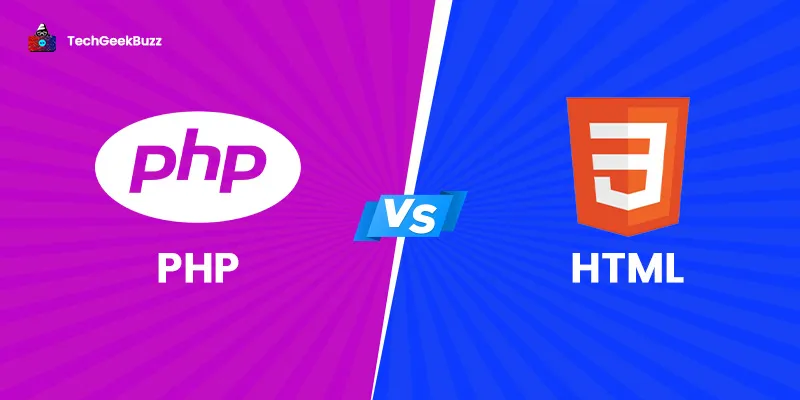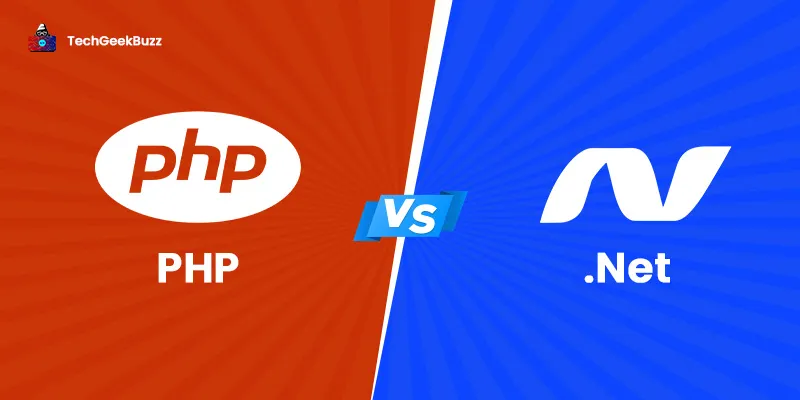The web development industry is at its tipping point since various businesses, from small-size to large-size, have shifted online. In general, web development refers to designing, creating, and maintaining websites, web applications, and other web projects.
When it comes to web development, PHP and HTML are the most preferred choices among web developers. Both these web technologies serve different purposes. WordPress, a content management system (CMS), is developed using PHP and HTML languages.
PHP is a server-side scripting language specially designed for web development and can be embedded into HTML. On the other hand, HTML is a standard markup language that helps developers create documents that get displayed in a web browser.
If you want to know how PHP and HTML are different technologies, you have landed on the right page.
This blog post aims at explaining the major differences between HTML and PHP. Also, it walks you through a detailed explanation of PHP and HTML, along with their features, advantages, and disadvantages.
So, let us get started!
What is PHP?
PHP stands for Hypertext Preprocessor. It is an open-source, server-side scripting language for creating static and dynamic websites and web applications. It is a popular choice for developing the back-end of websites and web applications.
Besides websites and web applications, PHP also has its applications in developing content management systems. Popular content management systems developed using PHP are WordPress, Drupal, WooCommerce, and Shopify.
Moreover, PHP has the ability to generate dynamic web page content, send and receive cookies, send emails, receive form data, create sessions, and encrypt the user’s data using various hash functions.
History
Rasmus Lerdorf, a Danish-Canadian programmer, designed PHP originally in 1994. Earlier, the full form of PHP was Personal Home Pages. This is because Rasmus Lerdorf initially created multiple Common Gateway Interface (CGI) programs for maintaining his personal home pages.
Later, he reworked those CGI programs to make them compatible with web forms and to interact with databases. He referred to this implementation of CGI programs as “Personal Home Page/Forms Interpreter" or PHP/FI. This implementation was capable of building simple and dynamic web applications.
Version 1.0 of PHP/FI was developed with the aim of speeding up bug reporting and improving code. This version included all the basic functionality that PHP possesses today. It included form handling, Perl-like variables, and the ability to embed into HTML code.
The year 1997 witnessed the release of PHP/FI 2. In the same year, Zeev Suraski and Andi Gutmans rewrote the PHP’s parser and formed the base of PHP 3. Also, they renamed PHP/FI to the recursive acronym: Hypertext Preprocessor. They officially released PHP 3 in 1998.
Later on, both these developers moved on to rewrite the core of PHP and developed the Zend Engine 1.0 in 1999, which formed the base for PHP 4. The year 2000 witnessed the release of PHP 4.
Further, many versions of PHP were released with the introduction of new features in each release. The latest and stable version of PHP is 8.1, released in 2021.
Features
The following are the salient features of PHP:
- Loosely-Typed Language: PHP is a loosely-typed language, which means that there is no need to declare the data type of variables. Depending upon the value of the variable, the data type is assigned to it at runtime. Also, it becomes possible to change the name of a variable dynamically.
- Cross-Platform Compatibility: PHP can run on any operating system, including Windows, Linux, and macOS. Also, it can run in any environment. The two most common environments are XAMPP (Windows, Apache Server, MySQL, Perl, and PHP) and LAMP (Linux, Apache, MySQL, PHP).
- Error-Reporting: This language supports various error reporting constants, including E_ERROR, E_WARNING, E_PARSE, and E_STRICT. These constants help in generating errors and warning at run time.
- Exception Handling: PHP5 supports exception handling, which means it is capable of handling errors at runtime.
- Memory Usage Information: This language supports functions, such as memory_get_usage() and memory_get_peak_usage(), that provide the memory usage information.
- Object-Oriented: PHP supports encapsulation and inheritance concepts of OOPs that result in increased speed.
- Magic Constants: In PHP, magic constants are the predefined constants that change based on their use. There are nine magic constants in PHP.
Advantages
Here are some remarkable upsides of PHP:
- It is an open-source language, and hence, anyone can use it.
- It is a platform-independent language, i.e., it can run on any operating system.
- If you are familiar with C programming, it becomes relatively easier to learn PHP since it has a low learning curve.
- It can seamlessly integrate with various databases, programming languages, and web technologies, including HTML, CSS, and JavaScript.
- PHP comes with a robust library that enables you to leverage various modules and functions for data representation.
- The structure of PHP is pretty simple and does not require writing lengthy code.
Disadvantages
The following are some significant downsides of PHP:
- Since PHP is open-source, all the ASCII text files are available to everyone. As a result, it is not secure.
- Due to its weak type, there may be chances where there might be incorrect knowledge to the user.
- You cannot make any modifications to the core behavior of online applications.
- It is pretty challenging to manage web applications using PHP since it is not component modular.
- It is not ideal for complex and large content-based web applications.
When to Use PHP?
Since PHP is a server-side scripting language, it is ideal to choose when you need to develop server-management functions within a web page or on the server itself. Also, it supports a lot of protocols, including HTTPS, IMAP, HTTP, NNTP, and POP3, making it ideal for system and database administrators.
What is HTML?
HTML stands for HyperText Markup Language. It is the standard markup language for creating appealing documents displayed in web browsers, and we refer to these documents as web pages. Basically, it describes the structure of web pages.
Moreover, there are various elements in HTML that serve as building blocks of HTML pages. There is a sheet style language called Cascading Style Sheets (CSS) that helps to customize the look and feel of these HTML elements.
To understand the definition of HTML better, let us define each term in it as follows:
Hypertext: This term simply refers to ‘Text within the text’. This means that a text has a link, and when we click on it, we get redirected to another web page, which we refer to as hypertext. In short, hypertext is a way to link two or more web pages together.
Markup Language: A markup language is a computer language that is basically a set of rules monitoring what markup information a document should include. It makes the text more interactive and dynamic. In other words, it is a computer language for applying layout and formatting conventions to a text document.
HTML code has the ability to incorporate any code written in scripting languages, such as JavaScript and PHP . In addition, an HTML document consists of multiple HTML tags, while each HTML tag contains different content.
More specifically, the primary use of HTML is to annotate the text so that computers can understand and manipulate it.
History
Tim Berners-Lee drafted a memo that proposed an internet-based hypertext system in 1989. In the following year, he wrote the browser and the server software and specified HTML. Lee was the contractor at CERN who proposed and prototyped ENQUIRE, a system for CERN researchers to use and share documents.
Later in 1991, Lee released a document called “HTML Tags” publicly that included the description of HTML. This document included 18 elements and was influenced by SGMLguid, the Standard Generalized Markup Language (SGML)-based documentation format at CERN. Out of these 18, eleven elements are still available in HTML 4.
In 1993, Berners-Lee and Dan Connolly published the draft that was the first proposal for HTML specification called ‘Hypertext Markup Language’. This draft expired six months after its publication. Similarly, Dave Raggett also published another draft named HTML+.
Both the drafts, HTML and HTML+, expired in 1994, and the HTML working group created HTML 2.0, which was completed in 1995. This version of HTML was intended to be the base for all future HTML implementations.
Further, the year 1997 witnessed the release of HTML 3, which was the first version as standardized as the W3C Recommendation. HTML 4 was also a W3C Recommendation version released in the same year. Finally, HTML 5 was released in 2014. The current version of HTML is HTML 5.2 released in 2017.
Features
The following are the notable features of HTML:
- It is a markup language that makes any text more interactive and dynamic.
- HTML can work on any major operating system, including Windows, Linux, and macOS.
- Using HTML, we can add text, images, videos, audio, and hypertext to a web page.
- It comes with a lot of formatting tags that help you make an effective presentation.
- It is a case-sensitive and static language.
Advantages
Some of the major advantages of HTML are as follows:
- It is very easy to learn and create web pages using HTML.
- All the major browsers, including Google Chrome, Internet Explorer, Safari, Edge, and Firefox, support HTML.
- It is a lightweight language and easy to load.
- It integrates seamlessly with other languages, such as JavaScript, CSS, and PHP.
- HTML supports the usage of templates that help you design a web page quickly.
- It has a huge and active community. Therefore, you can get instant help in case of any issues.
Disadvantages
Here are the significant disadvantages of HTML:
- Since HTML is a static language, it cannot produce dynamic output. This means that the web pages will not change until someone changes them manually.
- You need to write a lot of HTML code to create just a simple web page.
- Editing any web page is complex since you need to do it separately.
- It becomes challenging to handle lengthy and complex HTML code.
- With HTML, you can only create a simple web page. To add more functionality to your web page, you need to use other technologies.
- HTML is not secure. As a result, you need to use other third-party services to make it secure.
When to Use HTML?
Since HTML is a client-side or front-end language, its primary purpose is to alter or modify the appearance of web pages. Mostly, developers leverage HTML for changing the text format and appearance of web pages. More precisely, HTML is used to provide a structure to a web page.
PHP vs HTML - A Detailed Comparison
The following table draws a detailed comparison between HTML and PHP:
|
Parameters |
PHP |
HTML |
|
Acronym |
PHP stands for Hypertext Preprocessor. |
HTML stands for Hypertext Markup Language. |
|
Developer |
Rasmus Lerdorf, a Danish Canadian, designed PHP. |
Tim Berners-Lee designed HTML. |
|
Definition |
PHP is a server-side scripting language for web development. |
HTML is a front-end markup language for creating web pages. |
|
Usage |
Since it is a server-side language, it is used to create dynamic web pages, interact with databases, store data, send emails, create sessions, and provide content to HTML pages. |
It provides structure to a web page with its elements. |
|
Code Discipline |
PHP codes are dynamic. |
HTML codes are static. |
|
Extension |
To save PHP files, you need to use the .php extension. |
To save HTML files, you need to use the .html extension. |
|
Learning Curve |
PHP has a steep learning curve when compared to HTML. |
HTML is comparatively easy to learn. |
PHP vs HTML - Which One to Choose?
PHP is a server-side scripting language, while HTML is a client-side markup language. From the above discussion, we can conclude that both these languages serve different purposes and go well together. Since PHP and HTML are frequently used together, there may be chances that people get confused between the two.
Therefore, it is pretty unfair to state which language is better than the other one. PHP and HTML both work well, and the best example of it is WordPress, which is a popular content management system (CMS).
If you wish to build a completely static website, HTML is good to go. Along with HTML, you will also need CSS and JavaScript to optimize and finetune your website.
However, if you wish to create a dynamic website, you need PHP or any other server-side scripting language.
Conclusion
This was all about the differences between PHP and HTML. PHP is a server-side scripting and dynamic language, while HTML is a front-end markup and static language. The latter defines the structure and elements of a website, while the former controls HTML, CSS, and JavaScript sent to the web browser.
Moreover, HTML is the best choice if you don’t want anything in your website to change. However, if you want your website to be dynamic and connect to a database, such as MySQL, choosing PHP would be a great move.
To learn PHP, you can simply begin with tutorials available on the internet. Later, you can install PHP on your system and use an IDE to start practicing.
Frequently Asked Questions
1. Is PHP better than HTML?
PHP is ideal for creating dynamic web pages. The server executes the PHP code and returns the result in the HTML format that the web browser displays to the users. On the flip side, HTML is only capable of creating static web pages and cannot interact with the server. It is not ideal for creating dynamic web pages. Therefore, PHP is better than HTML for creating dynamic web pages.
2. Why is PHP used in HTML?
Only with HTML, it is not possible to create dynamic web pages. As a result, developers use PHP scripts with the HTML code in a PHP file to create dynamic web pages. In addition, using PHP allows access to various databases.
3. Is HTML a programming language?
No, HTML is not a programming language. Instead, it is a markup language that describes the structure of web pages.
People are also reading:





Leave a Comment on this Post